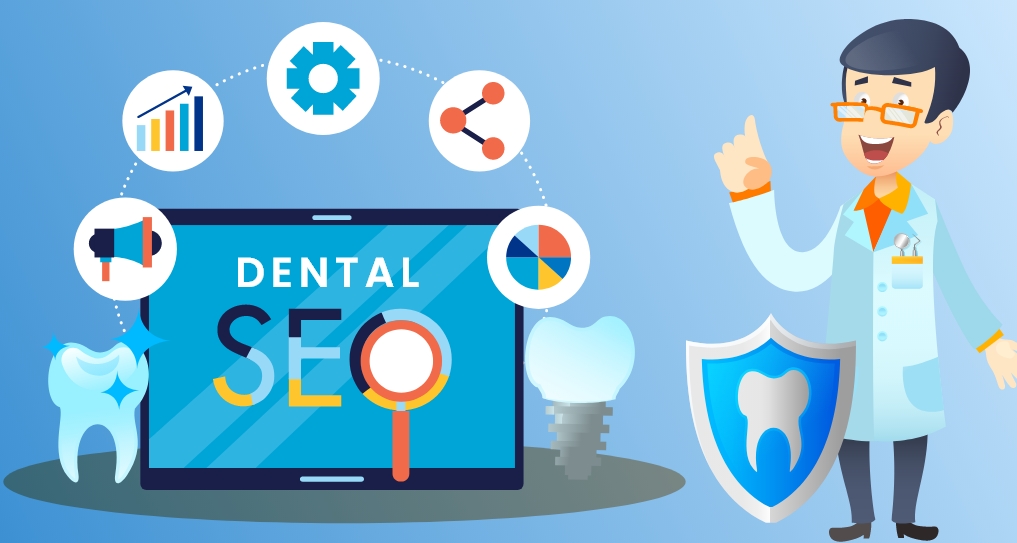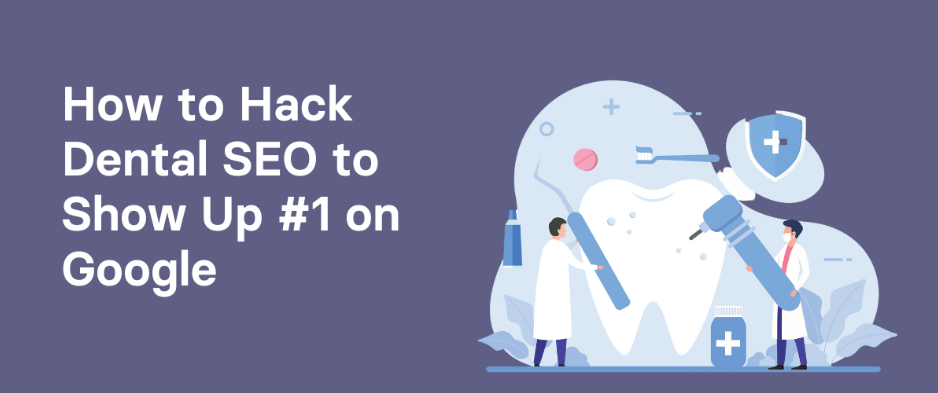In the vast digital landscape, standing out as a dental practice requires more than just general SEO efforts. Local Dental SEO is the key to ensuring that your practice is not only visible to a broader audience but also attracting the right local clientele. In this comprehensive guide, we’ll walk you through the essential steps of optimizing your dental website for local search.
Table of Contents
- 1. Understanding Search Engine Optimization
- 2. On-page Dental SEO Basics
- 3. Focus on the Dental Patient User Experience
- 4. Dental Practices Location Info
- 5. Use A Google Business Profile
- 6. A Tool For Rich Search Results
- 7. Write Content About Your Dental Services
- 8. Online Dental Practice Reviews
- 9. Keep Your Dental Website Up To Date
- FAQs
1. Understanding Search Engine Optimization
Search Engine Optimization, or SEO, is a multifaceted approach to enhancing a website’s visibility on search engines. Local dentist seo, however, adds another layer by focusing on relevance, distance, and prominence.
Relevance
In the realm of local SEO, relevance is paramount. To increase visibility in local searches, your website content must align closely with the specific dental services offered in your area. This involves incorporating relevant keywords naturally into your website’s content, meta tags, and headings.

Distance
The geographical proximity between the user and your dental practice is a crucial factor considered by search engines. Local SEO aids in narrowing down search results based on the user’s location, ensuring that individuals receive results that are most relevant to their physical proximity.
Prominence
Prominence in local SEO refers to how well-known and reputable your dental practice is. It goes beyond just online visibility and encompasses positive reviews, quality content, and a strong online presence. Search engines interpret positive reviews as a sign of trustworthiness and credibility. Encouraging satisfied patients to leave reviews on platforms like Google My Business enhances your practice’s online prominence.
2. On-page Dental SEO Basics
Keywords
Identifying and strategically incorporating dental keywords into your content is foundational for effective SEO. Keywords are the terms and phrases that potential patients might use when searching for dental services. By understanding the language your target audience uses, you can optimize your content to align with those specific search queries.
Headings
Properly structured headings play a dual role in on-page SEO. Firstly, they enhance the readability of your content, making it more user-friendly. Secondly, headings serve as signals to search engines, indicating the importance of specific sections within your content.

Meta Descriptions
Crafting compelling meta descriptions is a critical aspect of on-page SEO. A meta description is a summary that appears below the title in search engine results. It serves as a snippet that provides users with a concise preview of your page.
Interlinking
Interlinking involves strategically linking from one page on your website to another. This internal linking structure enhances the user experience by guiding visitors to related or relevant content within your site. From an SEO perspective, interlinking helps search engines navigate and understand the structure of your website.
Outbound Links
Including outbound links, or links to authoritative external sources, adds credibility and depth to your content. When you link to reputable sources, it signals to search engines that your content is well-researched and trustworthy.
3. Focus on the Dental Patient User Experience
Creating a user-friendly website is not just good practice; it’s a crucial element of successful dental SEO. In an era where smartphone usage is prevalent, optimizing your site for mobile users is paramount. A seamless mobile experience ensures that potential patients can access information about your dental practice anytime, anywhere.
Consider the responsive design of your website, ensuring that it adapts gracefully to various screen sizes. Mobile optimization goes beyond visual appeal; it includes optimizing page loading times, simplifying navigation, and ensuring that essential information is easily accessible on smaller screens. A positive user experience not only pleases your visitors but also contributes to higher search engine rankings.
4. Dental Practices Location Info
Accurate location information is the linchpin for local searches. When users search for dental services, search engines consider geographical proximity a decisive factor. Therefore, it’s imperative to provide precise location details on your website. This includes not only your address but also local landmarks and neighborhood information that helps search engines understand your exact location.
Optimizing your presence on Google Maps is a strategic move. This involves claiming your business on Google My Business, verifying your information, and ensuring that your location marker is correctly placed. A well-optimized location on Google Maps not only aids in local SEO but also makes it easier for potential patients to find your dental practice.
5. Use A Google Business Profile

Setting up and optimizing your Google Business Profile is akin to putting your dental practice on the digital map. This profile is a powerful tool for enhancing your local search presence. Ensure that your profile includes accurate business information, such as your address, phone number, business hours, and website.
Encourage satisfied patients to leave reviews on your Google Business Profile. Positive reviews not only contribute to your online reputation but also play a crucial role in local SEO. Search engines value businesses with positive reviews, considering them more relevant and trustworthy. Actively managing and responding to reviews can further strengthen your connection with the local community.
6. A Tool For Rich Search Results
Implementing structured data on your website is like providing a roadmap for search engines. Structured data, often in the form of Schema Markup, adds context to your content, helping search engines understand the meaning behind the information on your pages.
For a dental practice, structured data can include details such as business hours, services offered, and customer reviews. When search engines comprehend this data, they can present richer search results, including featured snippets, review stars, and other enhanced elements. This not only makes your results more visually appealing but also increases the likelihood of attracting clicks from users seeking dental services.
7. Write Content About Your Dental Services
Crafting content about your dental services is more than a formality; it’s a key component of successful online presence and dental SEO. When potential patients search for dental services, informative and well-structured content helps your practice stand out.
Dental Keyword Research Tools
To ensure your content is discoverable, use dental keyword research tools. These specialized tools help identify relevant keywords specific to dental services in your locality. Understand the terms potential patients will likely use when searching for dental care. Integrate these keywords organically into your content, including service pages, blog posts, and meta tags. This strategic approach enhances the visibility of your content in search engine results, connecting your practice with individuals actively seeking dental services.
Content Marketing with a Dental Blog
Maintaining an informative dental blog is a dynamic way to engage and educate your audience. Regularly publishing relevant and valuable content not only showcases your expertise but also keeps your website fresh and appealing to both users and search engines.
Share insights about dental procedures, oral health tips, and updates about your practice. This not only fosters a sense of community but also positions your practice as a reliable source of information. When creating blog content, consider your patients’ questions and concerns, addressing them in a conversational and accessible manner.
8. Online Dental Practice Reviews
Online reviews are the digital currency of trust for dental practices. Positive reviews build credibility and influence potential patients’ decisions. Implementing strategies to encourage and manage reviews effectively is essential for positive online reputation management.
Encourage satisfied patients to leave reviews on platforms like Google, Yelp, or specialized healthcare review sites. Make the process straightforward by providing links or guidance. Respond to reviews promptly and professionally, whether they are positive or negative. Managing reviews actively demonstrates your commitment to patient satisfaction and contributes to the overall perception of your dental practice.
9. Keep Your Dental Website Up To Date
Maintaining a current and dynamic dental website is not just good practice; it’s a fundamental aspect of a successful online presence and user experience. Regularly updating your dental website ensures that it remains relevant, informative, and secure. Here’s why keeping your website up to date is crucial:
Relevance
In the ever-evolving field of Cardiff dentistry, it’s essential to showcase the latest information about your services, technology, and any advancements in dental care. Regular updates ensure that visitors to your site receive accurate and current information about your practice.
Informativeness
Beyond basic information, your website is a valuable platform for sharing insights, news, and educational content related to oral health. Whether through blog posts, articles, or news sections, providing fresh and informative content keeps your audience engaged and positions your practice as a knowledgeable resource.
Security
Regular updates to your website’s backend, including content management systems, plugins, and security features, are crucial for safeguarding against potential vulnerabilities. Cyber threats are ever-present, and keeping your website software up to date helps protect sensitive patient information and maintains the integrity of your online presence.
Mobile Responsiveness
With a significant portion of internet users accessing websites via mobile devices, optimizing for mobile responsiveness is non-negotiable. An up-to-date website is more likely to be compatible with various devices and screen sizes, ensuring a seamless and user-friendly experience for all visitors.

FAQs
How long does it take to see results with dental SEO?
The timeline for SEO results varies, but improvements can often be noticed within a few months.
Is outsourcing dental SEO services a good idea?
It depends on your practice’s needs and resources. Evaluate the pros and cons before making a decision.
What role do patient reviews play in dental SEO?
Positive reviews contribute to prominence, a key factor in local SEO success.
How often should I update my dental practice website?
Regular updates are crucial. Aim for at least quarterly updates to keep content fresh.
Can I do dental SEO without technical knowledge?
While some aspects may be challenging, many SEO strategies can be implemented with a basic understanding. Consider hiring professionals for complex tasks.


